Map the Customer Journey and Drive Engagement
Learning Objectives
After completing this unit, you’ll be able to:
- Define your user personas.
- Map your customer journey.
- Drive user engagement.
User Personas and the Customer Journey
Erica and Linda know how an Experience Cloud site can help their business and customers thrive. They have the dream team in place to build it. And they have a good understanding of what content is already available. Next they need to make sure customers are interested in using the site.
To foster user engagement, the Cloud Kicks team needs to understand their customers’ needs and ensure the site includes compelling, relevant content. This requires understanding two key factors.
-
User personas, which represent specific types of users. Think of personas as fictional characters with real-world responsibilities, goals, and challenges.
-
Customer journeys, which map how customers use a product or service. A customer journey helps identify what customers want to accomplish and how they feel at each stage of their experience.
Erica and Linda identify three main types of user personas likely to visit the new Cloud Kicks site.
- Cloud Kicks superfan
- The Great Athletic Event supporter
- Casual shopper

To further develop these Cloud Kicks user personas, Linda and Erica answer some questions for each type.
Questions |
Cloud Kicks Superfan |
The Great Athletic Event Supporter |
Casual Shopper |
|---|---|---|---|
What are the user’s responsibilities, challenges, goals, and motivations? |
|
|
|
What do they want to accomplish on our site? |
|
|
|
Next, Erica and Linda consider the activities their user personas are likely to engage in on the Cloud Kicks website. They also reach out to the Cloud Kicks Support, Sales, and Marketing teams for input.
User Journey Questions |
Cloud Kicks Superfan |
The Great Athletic Event Supporter |
Casual Shopper |
|---|---|---|---|
What content does this user need to meet their goals? |
|
|
|
Is this user visiting our site/viewing our content for informational or learning purposes? |
Probably not |
Maybe |
Yes |
Are they accessing the site with desktop devices or with mobile devices? |
Either |
Either |
Either |
What do they do when they access the site? |
|
|
|
Which interactions are the most important? |
|
|
|
Erica and Linda have created a clear description of the users they anticipate serving with this site and what those users are looking for. They share their findings with the Cloud Kicks teams who own relevant content. For example, it’s helpful for Marketing to consider the different types of lifestyle photos that resonate with superfans and The Great Athletic Event supporters.
Promote Customer Engagement
Now that Erica and Linda know their target audience, they can design an Experience Cloud site that serves their users’ needs and considers the site vision and purpose they created back in the first unit.
They start with a focused list of user needs, based on the user persona exercise they just completed.
- Information about Cloud Kicks
- Information about the limited-edition sneakers
- Product availability notifications
- Lifestyle and fashion inspiration
Next, Erica and Linda create a list of site functionalities and features necessary to meet those user needs.
- Clear links to the main Cloud Kicks site
- Search functionality that spans the full Cloud Kicks online network
- Product information and content for the limited-edition sneakers
- Lead Form, so that customers can receive email notifications
- Photos, videos, and other multimedia content
Finally, they consider how to help customers find their site and engage with it.
- Link to the new site from existing online channels, like Cloud Kicks’s marketing and commerce sites, and social media accounts.
- Make the new site unauthenticated so it appears in online search results, and so casual shoppers can engage easily.
- Add a search bar to the top of the site’s landing page so customers can find the content they want, even if that content isn’t directly related to the limited-edition sneakers.
Erica and Linda have a clear idea of who their primary users will be and what types of content and features will motivate those users to visit and engage with the new Cloud Kicks site! This is a big step that will guide the Cloud Kicks team as they make decisions about how to build the site itself.
Resources
